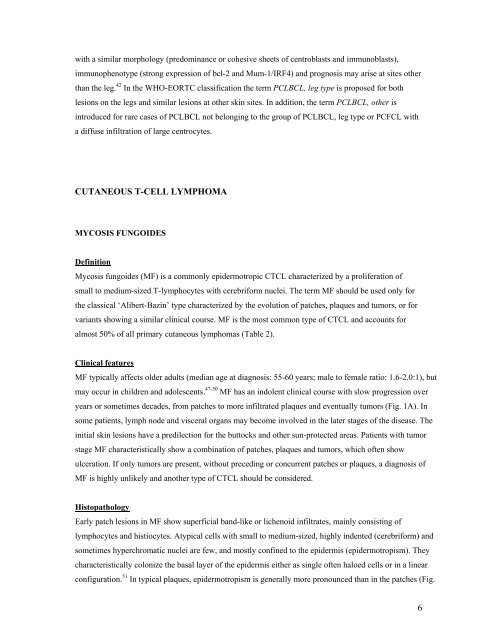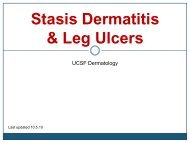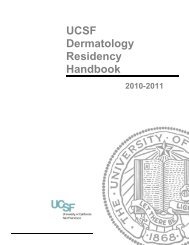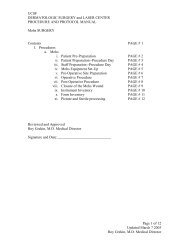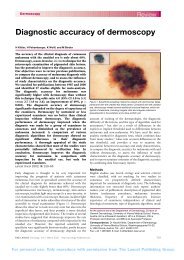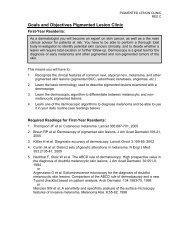who-eortc classification for cutaneous lymphomas - Dermatology
who-eortc classification for cutaneous lymphomas - Dermatology
who-eortc classification for cutaneous lymphomas - Dermatology
You also want an ePaper? Increase the reach of your titles
YUMPU automatically turns print PDFs into web optimized ePapers that Google loves.
with a similar morphology (predominance or cohesive sheets of centroblasts and immunoblasts),<br />
immunophenotype (strong expression of bcl-2 and Mum-1/IRF4) and prognosis may arise at sites other<br />
than the leg. 42 In the WHO-EORTC <strong>classification</strong> the term PCLBCL, leg type is proposed <strong>for</strong> both<br />
lesions on the legs and similar lesions at other skin sites. In addition, the term PCLBCL, other is<br />
introduced <strong>for</strong> rare cases of PCLBCL not belonging to the group of PCLBCL, leg type or PCFCL with<br />
a diffuse infiltration of large centrocytes.<br />
CUTANEOUS T-CELL LYMPHOMA<br />
MYCOSIS FUNGOIDES<br />
Definition<br />
Mycosis fungoides (MF) is a commonly epidermotropic CTCL characterized by a proliferation of<br />
small to medium-sized T-lymphocytes with cerebri<strong>for</strong>m nuclei. The term MF should be used only <strong>for</strong><br />
the classical ‘Alibert-Bazin’ type characterized by the evolution of patches, plaques and tumors, or <strong>for</strong><br />
variants showing a similar clinical course. MF is the most common type of CTCL and accounts <strong>for</strong><br />
almost 50% of all primary <strong>cutaneous</strong> <strong>lymphomas</strong> (Table 2).<br />
Clinical features<br />
MF typically affects older adults (median age at diagnosis: 55-60 years; male to female ratio: 1.6-2.0:1), but<br />
may occur in children and adolescents. 47-50 MF has an indolent clinical course with slow progression over<br />
years or sometimes decades, from patches to more infiltrated plaques and eventually tumors (Fig. 1A). In<br />
some patients, lymph node and visceral organs may become involved in the later stages of the disease. The<br />
initial skin lesions have a predilection <strong>for</strong> the buttocks and other sun-protected areas. Patients with tumor<br />
stage MF characteristically show a combination of patches, plaques and tumors, which often show<br />
ulceration. If only tumors are present, without preceding or concurrent patches or plaques, a diagnosis of<br />
MF is highly unlikely and another type of CTCL should be considered.<br />
Histopathology<br />
Early patch lesions in MF show superficial band-like or lichenoid infiltrates, mainly consisting of<br />
lymphocytes and histiocytes. Atypical cells with small to medium-sized, highly indented (cerebri<strong>for</strong>m) and<br />
sometimes hyperchromatic nuclei are few, and mostly confined to the epidermis (epidermotropism). They<br />
characteristically colonize the basal layer of the epidermis either as single often haloed cells or in a linear<br />
configuration. 51 In typical plaques, epidermotropism is generally more pronounced than in the patches (Fig.<br />
6


